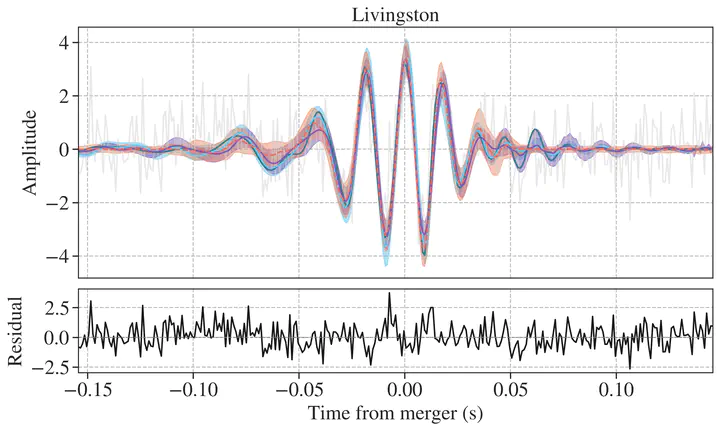 Top: Reconstruction of GW231123 waveform using AWaRe. Bottom: Residuals obtained by subtracting the AWaRe mean reconstructions from the whitened strains.
Top: Reconstruction of GW231123 waveform using AWaRe. Bottom: Residuals obtained by subtracting the AWaRe mean reconstructions from the whitened strains.Abstract
The LIGO–Virgo–KAGRA Collaboration recently reported GW231123, a black-hole merger with a total mass of around 190–265 solar masses. This event adds to the growing evidence of “lite” intermediate-mass black-hole (IMBH) discoveries, where the post-merger black hole exceeds 100 solar masses. GW231123 posed several data-analysis challenges owing to waveform-model systematics and the presence of noise artifacts called glitches. We present the first comprehensive machine-learning analysis to further validate this event, strengthen its astrophysical inference, and characterize instrumental noise in its vicinity. Our approach combines specialized tools for complementary analyses: GW-Whisper, an adaptation of OpenAI’s audio transformer; ArchGEM, a Gaussian-mixture-model–based soft clustering and density approximation software; and AWaRe, a convolutional autoencoder. We identify the data segment containing the merger with >70% confidence in both detectors and verify its astrophysical origin. We then characterize the scattered-light glitch around the event, providing the first physically interpretable parameters for this glitch. We also reconstruct the real waveforms from the data with slightly better agreement to model-agnostic reconstructions than to quasi-circular models, hinting at possible astrophysics beyond current waveform families (such as non-circular orbits or environmental imprints). Finally, by demonstrating high-fidelity waveform reconstructions for simulated mergers with total masses between 100–1000 solar masses, we show that our method can confidently probe the IMBH regime. Our integrated framework offers a powerful complementary tool to traditional pipelines for rapid, robust analysis of massive, glitch-contaminated events.